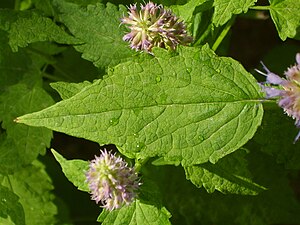Note: This is a project under development. The articles on this wiki are just being initiated and broadly incomplete. You can Help creating new pages.
Difference between revisions of "Agastache scrophulariifolia - Purple giant hyssop"
(Created page with "thumb|right|''Korean mint '', ''Agastache rugosa'' '''Korean mint''', known as '''Agastache rugosa''', '''blue licorice, purple giant hyssop,...") |
(No difference)
|
Revision as of 11:52, 4 January 2017
Korean mint, known as Agastache rugosa, blue licorice, purple giant hyssop, Indian mint, wrinkled giant hyssop, is an aromatic herb in the mint family, native to East Asia(China, Japan, Korea, Russian Primorye, Taiwan, and Vietnam).[1]
Contents
Description
Agastache rugosa is a perennial plant growing to 40–100 centimetres (16–39 in) tall, with square stalks that branch at the upper part.[5] The oval-cordate leaves are oppositely arranged, 5–10 centimetres (2.0–3.9 in) long and 3–7 centimetres (1.2–2.8 in) broad, with coarsely serrated margins.[5] Some leaves have hair and/or touches of white on the underside.
In July to September, purple bilabiate flowers bloom in verticillasters that are 5–15 centimetres (2.0–5.9 in) long and 2 centimetres (0.79 in) broad. The petals are 8–10 millimetres (0.31–0.39 in) long, lower ones longer and the ones in side serrated.
Uses
- The herb is used as an ingredient in varieties of dishes, such as buchimgae(Korean pancakes), chueotang(pond loach stew), and maeuntang(spicy fish stew).
- It is one of the 50 fundamental herbs used in traditional Chinese medicine.[2]
Agastache rugosa may have anti-atherogenic properties.
